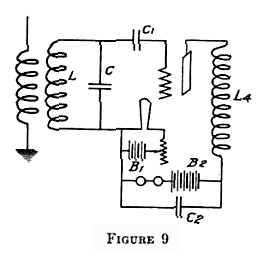Engineering:Audion receiver
An audion receiver makes use of a single vacuum tube or transistor to detect and amplify signals. It is so called because it originally used the audion tube as the active element. Unlike a crystal detector or Fleming valve detector, the audion provided amplification of the signal as well as detection. The audion was invented by Lee De Forest. In 1915 Edwin Armstrong described three common types of audion receivers.[1] The non-regenerative audion in Fig. 3, the tickler coil regenerative audion in Fig. 8 and the Miller effect regenerative audion in Fig. 9 that uses the same vacuum tube for RF amplification, RF detection, and audio amplification.
In Fig. 3, the LC circuit L and C select the receiver frequency. C2 is the gridleak capacitor and helps to demodulate the received signal. B1 is the A-battery or heater battery and B2 is the B-battery or anode battery.
In Fig. 8, L, C, B1 and B2 are as in Fig. 3. L2 and L3 have inductive coupling and implement the regenerative connection from grid to anode. C1 is the gridleak capacitor. C2 is a radio frequency bypass capacitor parallel to the speaker. Regenerative control is by changing the heater current via the rheostat next to B1.
In Fig. 9, L, C, B1 and B2 are as in Fig. 3. C1 is the gridleak capacitor. C2 is a radio frequency bypass capacitor. L4 is an inductance without inductive coupling to L. Together with the tube internal capacitor between anode and grid L4 creates a negative differential resistance at the grid. Regenerative control is as in Fig. 8.
In its operation, the circuit demodulates the radio frequency (RF) signal by rectification or square-law detection, and then amplifies this demodulated signal. The capacitor in series with the grid forms a grid-leak detector which allow the grid to cathode to be used as a diode. A high vacuum tube needs a gridleak resistor parallel to the gridleak capacitor.
See also
References
- ↑ Edwin H. Armstrong, Some recent developments in the audion receiver, Proceedings of the Institute of Radio Engineers, September 1915, pages 215-238
 |




